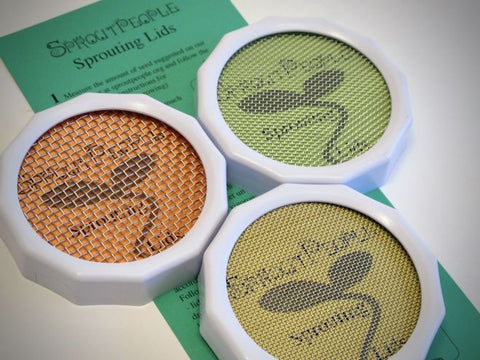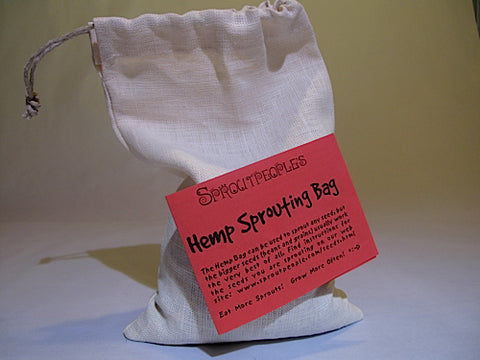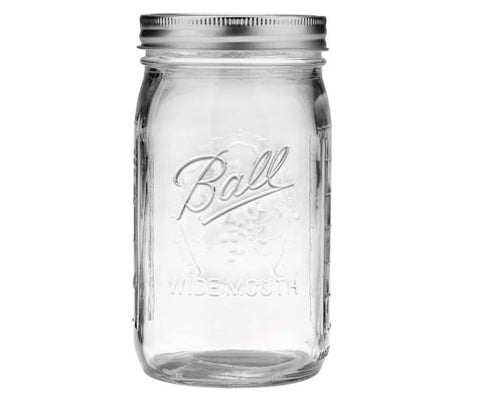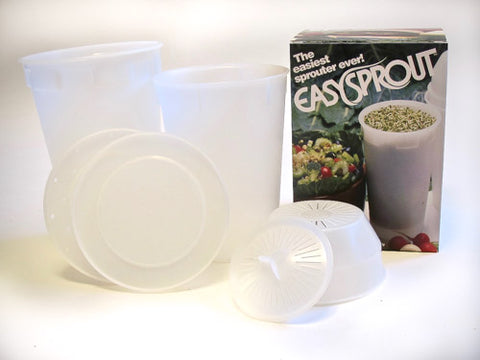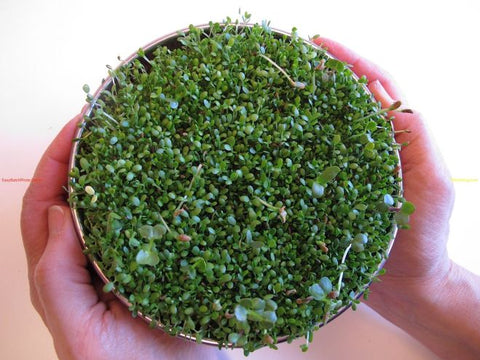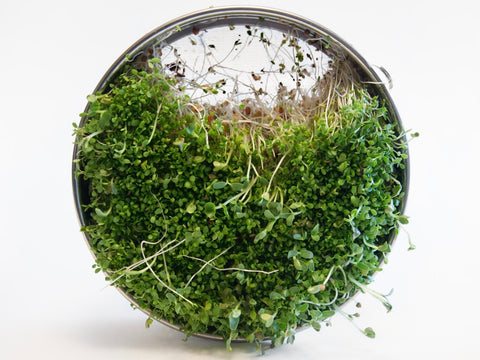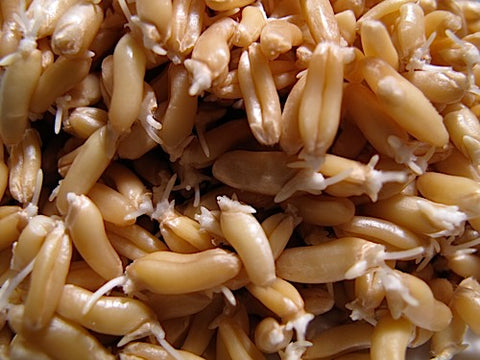
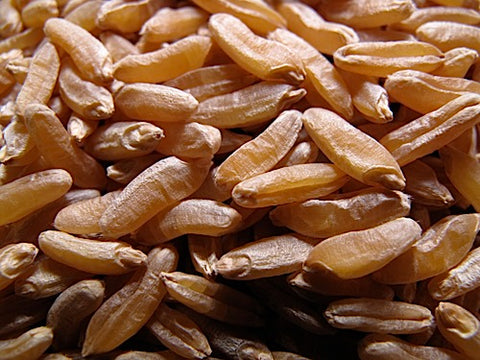
Kamut® Sprouts
The most beautiful big grain we've ever seen! Sweet, Easy to grow, Nutritious, Ancient.
Vitamins B, C and E
Calcium, Iron, Magnesium, Pantothenic Acid, Phosphorus
Amino Acids
Protein: 15%
Lovely, big, fat, chewy rich grain. Wonderful breakfast cereal, living bread, cookies, or grain salad.
The amount of Kamut® Sprouts produced by 1 unit of Seed. For Example 2:1 means that 1 pound of Seed will produce 2 pounds of Sprouts or whatever crop you are growing. You do not have to grow them all at once of course, unless you wish to =:-D
The time it takes to grow a finished 2 - 3 days, or other crop (Micro-Greens, Grass, Greens) from a dry Seed. Note: This "finished" Sprout is our preference. you may grow them for as long as you want! In fact, we suggest that you taste them at every rinse to discover when you like them best.
How to Grow Kamut® Sprouts
- Soak 1/3 to 1 cup of grain in cool water for 6-12 hours.
- Drain off soak water. Do not ever soak again.
- Rinse thoroughly.
- Drain Thoroughly.
- Rinse and Drain with cool water every 8-12 hours.
- Grain Sprouts don't need light. Keep your Sprouter in a low light location.
- Harvest on day 2 or 3, when most of the grains have short roots. Refrigerate your crop.
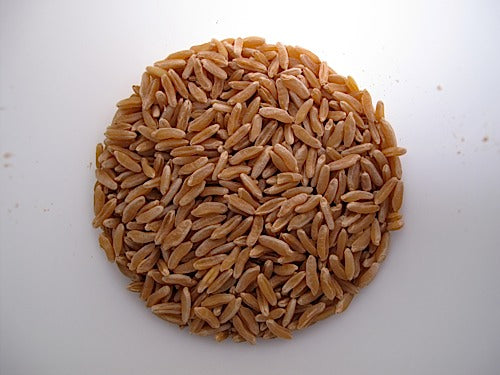
Dry Kamut Ready and eager to be Soaked.
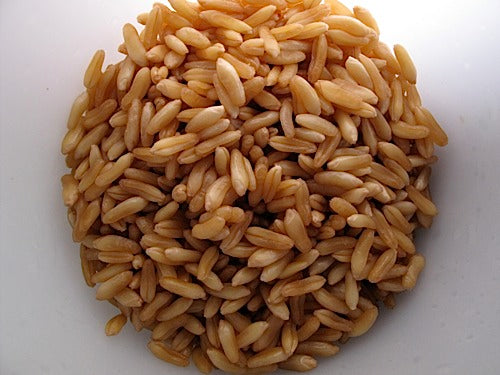
6-12 Hours later...Soaked, Rinsed and Drained.
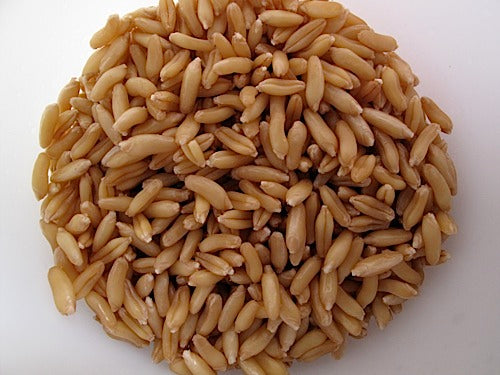
12 hours later... Another Rinse/Drain cycle.
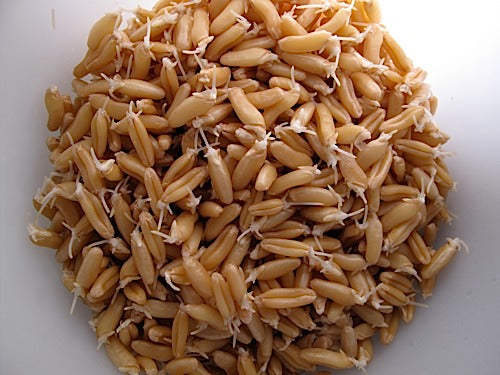
12 hours later... Another Rinse/Drain cycle, or skip it and Harvest your crop instead.

Dry Kamut Ready and eager to be Soaked.

6-12 Hours later...Soaked, Rinsed and Drained.

12 hours later... Another Rinse/Drain cycle.

12 hours later... Another Rinse/Drain cycle, or skip it and Harvest your crop instead.
Yields approximately 1 Cup (1/2 lb.) of Sprouts
Prep 2/3 cup of seed* then transfer (if necessary) into a bowl or into your Sprouter. Add 2-3 times as much cool (60°-70°) water. Mix seeds up to assure even water contact for all. Allow seeds to Soak for 6-12 hours. Empty the seeds into your Sprouter (if necessary). Drain off the soak water. You may water plants or use it in stock if you like - it has nutrients in it. Rinse thoroughly with cool (60°-70°) water. Drain thoroughly!
Set your Sprouter anywhere out of direct sunlight and at room temperature (70° is optimal) between Rinses. This is where your sprouts do their growing. We use a counter top - in the corner of our kitchen, but where the sprouter won't get knocked over by cats, dogs, kids or us. We don't mind the indirect sunlight or the 150 watts of incandescent light, because light just does not matter much. A plant can only perform photosynthesis when it has leaves. Until then light has little if any effect. They also happen to like air-circulation, so don't hide your sprouts.
Rinse and Drain again in 8-12 hours. And, perhaps one more... Rinse and Drain in 8-12 hours.
We usually stop here. We like our Grain Sprouts very small.
Depending on your climate and the time of year you are sprouting and most importantly your personal preference - You may Rinse and Drain again at 8-12 hour intervals for several days. However - we prefer to sprout only to the point where most of the seeds have sprouted tiny (1/16 - 1/4 inch) roots. That is typically after just 2 or 3 Rinse and Drain cycles, though it can happen after just one.
As always, we suggest that you taste your crop at EVERY Rinse - including the very first - just after the Soak period. The soaked seeds are already alive and though they may not be their most nutritious they are very close. We're talking seriously nutritious - they are already without enzyme inhibitors (a very good thing indeed) so they'll digest themselves and nourish your cells without requiring anything from your body!
Grow them for as long as you like (as long as you continue to Rinse and Drain every 8-12 hours) and find out for yourself when they are most delicious! If you grow for more than a couple days, you'll have Grass growing as well as roots.
Experiment! Have Fun! It's All Good!
Harvest Your sprouts are done 8-12 hours after your final Rinse. Be sure to Drain them as thoroughly as possible after that final Rinse. The goal during the final 8-12 hours is to minimize the surface moisture of your sprouts - they will store best in your refrigerator if they are dry to the touch.
Refrigerate Transfer the sprout crop to a plastic bag or the sealed container of your choice. We have Produce Storage Bags that will extend shelf life substantially.
Note: Grains do not store well in refrigeration so you should try to grow just what you need. It isn't actually that they store poorly, it is just that grains are cool weather crops, so though they slow down quite a bit, they continue to grow - even in the refrigerator.
* If using Sproutpeople's Single Harvest Pack - use the whole bag. It will produce a crop of approximately 8 ounces.
These seeds yield approximately 1.5:1 - which means the sprouts will weigh one-and-one-half times as much as the seed you start with, so you can theoretically start with 2/3 as much dry seed as your Sprouter's capacity, though we always suggest you leave more room - especially when you are new to a crop.
Kamut® is an ancient grain which is now a patented US product. The story is that a farmer from Montana found some seeds while serving in Northern Africa during WWII. He brought the seeds back to the family farm and after years of raising the crop applied for and was given a patent by the US government. Whatever the case, this is a truly awesome grain! It is bigger than wheat and slightly less sweet as well as more tender. Kamut is something that varies quite a bit year to year. This lot of seed is the most beautiful we've ever seen - and it sprouts wonderfully! You can theoretically grow grass from our Kamut. Wanna know how? Follow these directions. You can use Kamut to make Rejuvelac. We prefer Rye, but any Grain can be used.
Recommended Sprouters for Kamut® Sprouts
Chewy, mild flavor, I stir them into yogurt or add them to smoothies. I sprout 2/3 cup in a wide-mouth glass quart canning jar using the largest mesh of the "3 Screen Lid Set" stainless steel sprouting screens.
Chewy, mild flavor, I stir them into yogurt or add them to smoothies. I sprout 2/3 cup in a wide-mouth glass quart canning jar using the largest mesh of the "3 Screen Lid Set" stainless steel sprouting screens.

